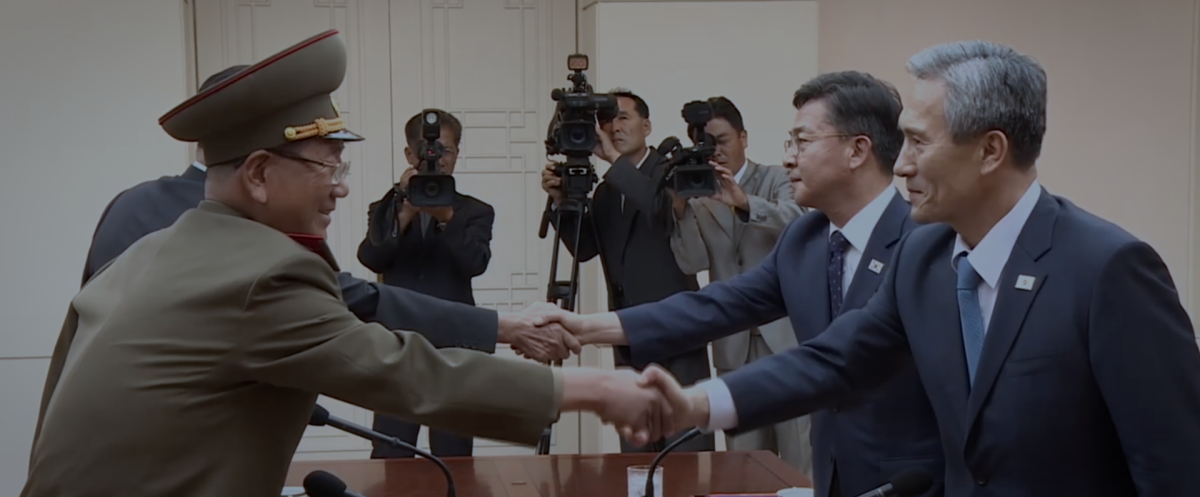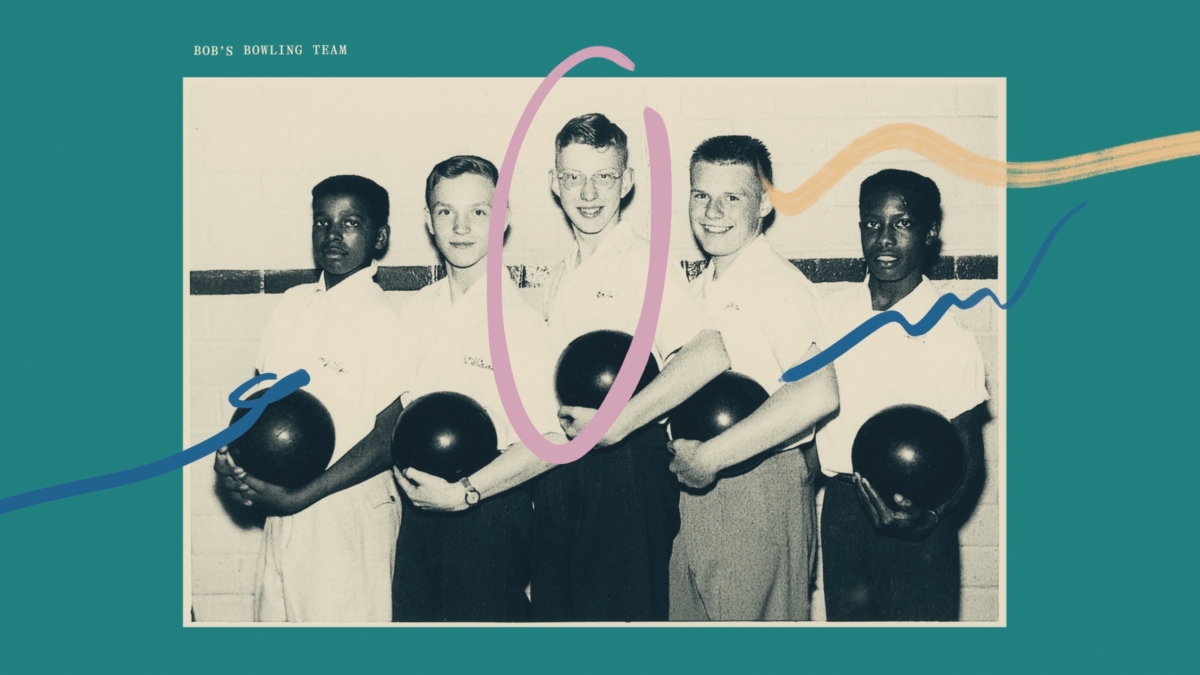Panmunjom is an old village in the demilitarized zone, the 2.5-mile-wide buffer that bisects the Korean peninsula, where an armistice agreement was signed in 1953 and ended three years of war. More than 70 years on, Panmunjom remains frozen in time. Troops still guard opposite ends of the powder-blue buildings that straddle the North-South border, each marked T for Temporary.
Touring Panmunjom in 2023, filmmaker Song Won-geun started to question its largely defunct status. It was then that he saw the potential for a feature-length documentary that could track how negotiations for peace ended in a state of limbo. Panmunjom: The Front Lines of Ideology is an emotionally spare, though not scholarly, close-up of the so-called truce site, illustrated with a trove of archival footage dug up from the U.S. National Archives. But the engine behind the film is the interviews with historians and eyewitnesses that detail the complexity of the conflict without drawing on rote narratives about ideological differences.
Panmunjom fittingly premiered at DMZ International Documentary Film Festival. Three weeks into its June 2024 theatrical release in South Korea, Documentary met with Song in the ground-floor cafe of Newstapa, an independent investigative news outlet in Korea where Song works as a producer. In this interview, edited for length and clarity, Song discusses historical documentary filmmaking and storytelling with specificity.
The interview was conducted in Korean and translated into English by the writer.
DOCUMENTARY: Was it challenging to find characters with first-hand accounts for something that happened so long ago?
SONG WON-GEUN: Fortunately, some people from that era are still alive, and we could choose our interview subjects very intentionally. For example, one of the most intense negotiations that occurred in Panmunjom was over setting the military demarcation line, which would be determined by the front line. So we wanted to speak to someone who had fought that specific battle. Yoo Jae-sik from the Korean War Veterans Association gladly agreed to speak with us, since the Korean War is starting to recede in the public’s memory. It made me emotional to hear him talk about how he had to kill just to survive and use piled-up corpses as barricades against bullets. He was completely unaware that a cease-fire was in discussion.
D: You also speak with people who can show the tensions that came after, like Kim Shin-jo, the North Korean spy who was dispatched to assassinate the South Korean president and captured alive.
SWG: I’m of a generation that was shown anti-communist educational videos about him in elementary school. When I managed to find Kim Shin-jo and asked him to introduce himself, he rattled off a biography that he’s presented repeatedly for the past fifty years—from his birthplace and family to his education and conscription history—almost like a rapper. He’s a pastor now, but he’s made the rounds at various military units to testify as sort of a pawn in years of psychological warfare. It really gave me the chills. Our interview was attended by someone, possibly from the military authorities or the National Intelligence Service, who I was told accompanies him for every media-related request.
D: Did you feel the need to verify their memories with archival records?
SWG: Yes. But it’s not like the videos were taken with cell phones. A good number of them were staged by the U.S. military, or so it seemed to me at least. I found multiple takes of the same group of soldiers running in different directions in the same place and cannons firing on cue. There didn’t seem to be much authentic footage from an actual active battlefield. And I’m not here trying to make scripted TV. It’s really the characters who speak from experience that bring the footage to life, so in a way, the testimonies come first, and the archival footage supports and visualizes the testimonies.
D: The way the shots were framed struck me as very cinematic.
SWG: Because they shot it like a movie!
D: What was the archival footage used for when it was created?
SWG: At the time, it was used in U.S. Army productions. One example is The Big Picture (1951–1964), which drew huge numbers of viewers and was meant to explain to America what exactly it is that the U.S. military does around the world. After the Korean War, the United States did provide aid and materials to build schools and hospitals and orphanages, and they could get shots of American soldiers surrounded by grateful-looking children. It’s good publicity. The resounding message is that America is here to help, not for violent occupation.
D: Most of your archival footage is from the U.S. How did you feel about the lack of homegrown records about the Korean War?
SWG: It didn’t feel strange to me that a poor country couldn’t afford to film. Even now, if you want to find records on Korean democracy movements from the 1970s, you have to go to Japan. But records on the Korean War are continuing to be excavated to this day. I’d like to check out the archives of countries in Europe that participated in the Korean War from the Communist side, like Hungary.
D: The Korean War is often known as the “forgotten war.” For the first half of the film, you zero in on an even more obscure issue, about the prisoners of war.
SWG: The central sticking point in Panmunjom was over the repatriation of POWs. The U.S. wanted to let the POWs choose where they would end up, but the Communist forces wanted to follow the Geneva Convention and return them to their homelands. The two sides couldn’t reach an agreement, and talks dragged on for over 20 months. And the POWs weren’t just sitting in prison cells. They fought extensively with one another within the camps. This is something most people know very little about, and I wanted to take this opportunity to inform.
D: You’re still looking to premiere the film internationally. Do you ever worry that this level of detail could be difficult to grasp for an audience unfamiliar with Korean history?
SWG: Not at all. There’s been a deluge of content about the Second World War. I got the impression those films dealt with the same events, with different directors who bring their worldviews. One doc series I watched about ideological wars presented everything as an American story, and I found it woefully insufficient. In any case, the Korean War occurred in Korea, so I wanted to explore Panmunjom as a truce site that hasn’t changed much for 70 years, without necessarily taking sides or seeing it through the lens of another powerful country.
We did have to go through another round of editing to reflect the developments since last October, like the scrapped 2018 military pact. We also had to pare down some of the experts to make it seem less academic and expand on the first-person witnesses. We were on the fence about including the last scene of former President Moon Jae-in and Kim Jong-un in Panmunjom, because it could be interpreted in a political way, but ultimately left it in since the president has a duty to work towards reunification, according to the constitution. It’s just not the case with the current administration.
D: The latest development in inter-Korean hostilities was North Korea’s launch of excrement-carrying balloons. Would that kind of thing help stoke the interest of international audiences?
SWG: It might, for North Korea watchers, but apparently for others hearing about it for the first time, it could trigger a sense of revulsion. Our marketing team said that any kind of mental association between Panmunjom and the balloons is no good. But Panmunjom is still a top destination among international tourists, who are granted much easier access than Korean citizens. So if they’ve already been there or want to go, I think the movie could reshape their understanding of Panmunjom as something more than a tourist attraction.




